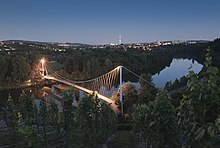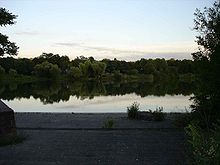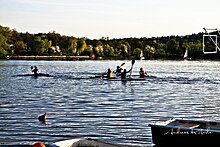Max-Eyth-See
| Max-Eyth-See | ||
|---|---|---|

|
||
| Max-Eyth-See | ||
| Geographical location | Baden-Wuerttemberg , Germany | |
| Tributaries | no | |
| Drain | Neckar | |
| Places on the shore | Hofen | |
| Location close to the shore | Stuttgart | |
| Data | ||
| Coordinates | 48 ° 50 '7 " N , 9 ° 13' 8" E | |
|
|
||
| Altitude above sea level | 214 m above sea level NHN | |
| surface | approx. 17.3 ha | |
| Maximum depth | 2.3 m | |
|
particularities |
Created in 1935 as a gravel pit, swimming is prohibited by law |
|
The Max-Eyth-See in Stuttgart is an artificially created lake directly on the Neckar , at the foot of vineyards between Mühlhausen and Hofen .
history
In the 1920s, gravel was extracted from an increasingly growing pit in Hofen, which is the origin of today's Max-Eyth-See. In 1935, Stuttgart's largest lake was created when the Neckar was canalized. From 1935 until the beginning of the Second World War, a lido was set up on the south-east bank. At that time the lake was not an actual lake, but an extension of the Neckar with lovely details such as B. a lighthouse and excursion boats. Several sailing regattas were held on the lake, including motorboat races in 1953 and 1954 . In 1961 the area and the lake were placed under landscape protection. The lake is 575 meters long and 345 meters wide and is divided into two legs by a peninsula. The lake is named after the Swabian engineer and writer Max Eyth (1836–1906). During the Second World War, the lake served as a point of reference for pilots, so a dam was built and the lake was pumped dry. A dam burst in 1949 filled the lake again with water. Two decades later, the site underwent a fundamental redesign, and bank zones were redefined and reinforced.
However, there was no supply of clean groundwater and in summer there was often an algal bloom. A groundwater inflow set up in 2010 and the sealing off of the dam leading to the Neckar have improved the water quality a little, but the susceptibility to algae blooms and a lack of oxygen remains.
leisure
The extensive area around the lake is one of many local recreation areas for the people of Stuttgart. You can hike, walk, bike or inline skates on the paths around the lake. There are large lawns with old trees and a few barbecue areas as well as a small, man-made sandy beach on the peninsula jutting out into the lake. There is a rental of pedal boats, row boats or electric boats. However, swimming in summer and ice skating in winter is prohibited. There is also fishing at the lake. In addition to a small beer garden on a peninsula, there are two restaurants, each with a large beer garden, the Haus am See and the club restaurant of the DLRG Treffpunkt am See . Up to 15,000 people crowd in the area on weekends.
nature
The great diversity of species and the natural bank landscape of the lake, which is under landscape protection, has become a habitat for many rare animals and plants in the middle of the city. In the north-western part of the lake, three bird protection islands are designated as the European bird sanctuary " Vogelinsel Max-Eyth-See ", which are home to gray geese, swans, pond and coot, cormorants and gray herons . The Württemberg fishing club has voluntarily refrained from fishing the northwestern part of the lake for decades. The Max-Eyth-See together with the adjacent Neckar form a habitat for kingfishers . In the past you could still see great crested grebes on the lake . These were apparently displaced by the growing cormorant colony. Since 2018, non-native bird species such as Egyptian goose and black swan have been encountered more and more frequently . On the lakeshore live u. a. Squirrel and weasel .
Especially because of the sport boat operation, no structures that improve the habitat of the fish can be introduced into the water. To create more spawning opportunities, the Württemberg Anglers' Association introduced artificial spawning aids in 2011, which were removed after the breeding season.
The Max-Eyth-See is an excessively nutrient-rich, very productive standing water that suffers above all from the high production of small algae and zooplankton . In addition, the lake is fed almost exclusively with Neckar water. Especially in hot summers, the lake is regularly threatened with tipping over , with a water fountain, which is switched on when necessary, introducing oxygen into the lake.
Water quality and fish death
After a cold spring, in the hot summer of 2015 there was a fatal lack of oxygen for many fish , which was combated with additional fresh water supply, circulation and ventilation for a short time. With the help of iron (III) chloride , phosphate was to be bound in the lake in spring 2016 .
Due to drought and an increased water temperature, blue-green algae formed more and more in August 2019 . A warning has been issued because they release toxins that can be harmful to human health. Due to the massive spread of blue-green algae, the plants in the lake did not get enough light, died and sank to the bottom. On the ground, these plants were broken down by cyanobacteria using oxygen. More oxygen was used in the lake than was able to get into the lake. As a result, the oxygen content of the water fell to around 1.5 milligrams per liter on September 2nd. With values below four milligrams per liter there is a critical situation for fish. On the evening of September 1st, the technical relief organization began to circulate the water with the help of a pump and enrich it with oxygen. The Württemberg fishing club also used aeration pumps. With the support of the local THW branches in Böblingen, Backnang and Ludwigsburg, the pumping capacity was increased to 21,000 liters per minute. Nevertheless, a large part of the fish population has died since the lake fell over, around 50,000 fish. Even turtles that come into the air to breathe have died from the poisons of the algae.
Projects and initiatives
In January 2008 the initiative “The Max-Eyth-See Stuttgart should get clean” was brought into being by the cabaret artist Christoph Sonntag with the support of the Landesstiftung Baden-Württemberg , numerous partners and sponsors. From April to the beginning of June 2008, as the first step between the EnBW pumping station in Hofen and the Max-Eyth-See, the first aqueduct was built, which since then has supplied the lake with 7 l / s of clean groundwater over the summer months.
At the end of July 2008, the Christoph Sonntag scholarship supported a project by the Mühlhausen Youth Council and financed the construction of a sandy beach directly on Lake Max-Eyth.
In March 2009 the groundbreaking ceremony for the classroom by the lake took place . With the building, a freely accessible space was created directly on Lake Max-Eyth, which is an “open-air” classroom especially for school classes on the subjects of “nature, water and ecological cycles”. In July 2009 the structure was inaugurated as part of the SWR3 SEEFEST 2009.
At the end of March 2010, construction work on the second fresh water pipe began and was completed before summer 2012. Since April 2012, an additional 33 l / s of fresh water has been fed into the lake on the south bank in the summer months. By 2012, around 1.3 million euros had been invested in cash and in kind. In the years up to June 2015, the water quality had improved by 30 percent.
The bathing ban remained in place despite the fresh water pipes. Regular water tests should be the basis for decisions on how to proceed by the end of 2013.
Clubs and associations
- The Württemberg fishing club is based here.
- The regional association of the German Life Saving Society ( DLRG) and the DLRG youth have their offices on Max-Eyth-See. A little further in the direction of the Neckar is the rescue center of the DLRG district of Stuttgart.
- Well-known clubs and boat clubs have their moorings on the shore, such as B. the Academic Sailing Association Stuttgart, the Stuttgarter Kajak Club (StKC), the Marineverein Stuttgart 1899 and the Stuttgart Sailing Club.
- The Stuttgarter Jugendhaus gGmbH has been operating the thatched boathouse for children and youth work since 1971.
Directions
- The Max-Eyth-See stop is served by the U12, U14 trams and the 54 bus.
- There are some parking spaces at the Haus am See , and there are also parking spaces near the tram stop.
photos
Web links
- Canoe polo on the Max-Eyth-See Stuttgart
- Classroom at the lake / Max-Eyth-See Stuttgart
- Landscape protection area Max-Eyth-See, Stuttgart
Individual evidence
- ↑ stuttgart.de
- ↑ Archived copy ( Memento from July 22, 2010 in the Internet Archive )
- ↑ Lack of oxygen in the water: fish saved in Max-Eyth-See. In: stuttgarter-nachrichten.de. Retrieved April 13, 2016 .
- ↑ Max-Eyth-See in Stuttgart: iron chloride runs uncontrolled into the lake. In: stuttgarter-zeitung.de. Retrieved April 13, 2016 .
- ^ Konstantin Schwarz: Blue-green algae in Max-Eyth-See: City warns of water contact. Stuttgarter Zeitung , August 28, 2019, accessed on September 21, 2019 .
- ↑ Julika Wolf: Fish die in Stuttgart: What happens to the Max-Eyth-See? Stuttgarter Zeitung , September 6, 2019, accessed on September 21, 2019 .
- ↑ Max-Eyth-See in Stuttgart: Blue-green algae let fish die. Stuttgarter Zeitung , September 2, 2019, accessed on September 21, 2019 .
- ↑ Julika Wolf: Anglersverein zum Fischsterben im Max-Eyth-See: “Biggest natural disaster that has ever occurred in Stuttgart”. Stuttgarter Zeitung , September 4, 2019, accessed on September 21, 2019 .
- ↑ Julika Wolf: Max-Eyth-See: The fight for the fish is lost. Stuttgarter Zeitung , September 4, 2019, accessed on September 21, 2019 .
- ↑ Christoph Sonntag grant
- ↑ Max-Eyth-See: unobstructed view to the bottom. In: stuttgarter-nachrichten.de. Retrieved April 13, 2016 .
- ↑ Many partners help save the Max-Eyth-See . In: Stuttgarter Zeitung . January 28, 2008.
- ↑ Christoph Sonntag grant







